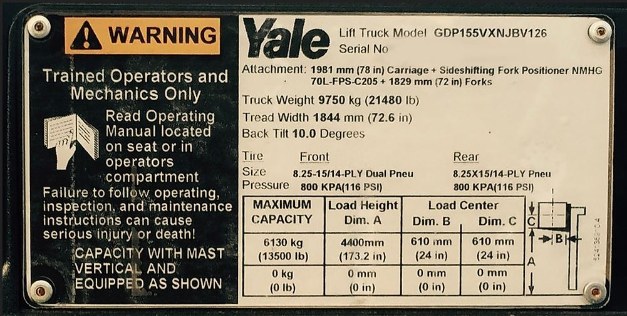How to Read a Forklift Data Plate
To ensure forklifts and materials handling equipment (MHE) are operated safely within their maximum limitations, under Australian Standard AS2359.2 – 2013 all forklifts and MHE are fitted with a rating plate by the manufacturer.
The rating plate clearly states the unit’s specifications and operating limits so that operators do not unsafely push a units operational capabilities beyond the safe limits specified by the manufacturer.
This blog will explain how to read and understand the specifications on a forklift rating plate.

1. Forklift Model
The forklift model the rating plate is attached to is clearly stated at the top of the plate.
The model of forklift is vitally important when communicating with the manufacturer or dealer regarding repairs, technical help and spare parts.
Being able to provide the forklift model when there is a fault technicians are able to look up the particular model to see if it is a common fault and how to fix it for the particular model.
Quoting the forklift model easily allows parts interpreters to select the correct parts that are specifically compatible with that model of forklift when supplying spare parts.
2. Forklift Serial Number
A forklifts serial number is also vitally important when communicating about repairs, technical help and spare parts.
It is a more precise way of finding out information on a specific forklift than a model number as they are unique to each unit.
Providing a technician or a parts interpreter with a unit’s serial number allows them to pull up the individual record of the forklift to see the unit’s precise setup and history, allowing them to match parts or troubleshoot known issues easily.
3. Year of Manufacture
States what year the forklift was manufactured.
Can assist in procuring the correct spare parts or troubleshooting known issues as units manufactured in specific years usually will share the same specifications or technicians know a specific model of forklift manufactured in a specific year are prone to a specific fault.
4. Nominal Power
States the nominal power (the average power consumed by the forklift) in kilowatts of the specific forklift.
5. Attachment
This lets owners and operators know if any attachments are fitted to the unit and what they are.
This gives a clear indication of the forklifts capabilities. In the example data plate above we see the Hyster 2.5T XT forklift is fitted with a side-shift carriage so the carriage and tynes can be shifted left and right of center as well as tynes that are 1,070mm long.
6. Truck Weight
Shows the forklifts overall weight without any load on the tynes.
The unladen weight of a forklift can be crucial for operators ensuring that any surfaces or areas they are planning on operating the forklift over are rated to specifically handle not only the full weight of the empty forklift but the weight of the forklift when it is carrying a full load weight.
7. Forward Back Tilt
Shows the specific number of degrees that the mast on the forklift can be tilted backwards and forwards.
8. Tyre Information
Details the specific size and type of that are fitted to the forklift.
This is helpful when ordering replacement tyres as all the information from the data plate can be relayed to a parts interpreter to ensure the correct tyres are ordered. When purchasing a new or used forklift the rating plate tyre data shows what is currently fitted to the forklift.
If the application the forklift is being purchased for requires a specific type of tyre such as non-marking tyres then buyers are able filter out any forklifts that do not have the correct tyre type via the information on the data plate.
9. Tyne and Mast Specifications
The load table that occupies the bottom half of the rating plate is critical for the safe operation of the forklift. The data in the table specifies important information regarding the forklifts load handling capabilities:
- Load Height is the maximum height the forklift mast can lift a load
- Maximum Capacity Mast Vertical is the maximum weight the forklift can lift when the mast is extended to its full height. The mast must be vertical and upright not tilted
- Maximum Capacity Mast Tilted Forwards is the maximum load weight the forklift can lift when its mast is titled forwards within the degree limit listed on the load plate
- Load Centre – is the balance point of the load where it is the most stable and secure, it is imperative to keep all loads central when lifting otherwise the risk of the forklift becoming unbalanced and tipping over greatly increases
10. Driver and Operator Warnings
Owners and operators are reminded that they need to be fully trained and hold the correct license to operate the forklift safely.
They need to read all the necessary manuals before commencing operations.

This blog provides a brief guide on how to read and interpret the critical information displayed on your forklift rating plate.
It is imperative that all forklift owners and operators familiarise themselves with a units rating plate, before they begin operations to ensure their own safety and those around them as well as property and equipment safety.
It is also imperative that damaged or unreadable rating plates are replaced via the original equipment manufacturer at the first sign of damage.
As the exclusive supplier of the full range of Hyster, Yale, Combilift and Liftsmart forklifts and materials handling equipment in Australia, Adaptalift Groups spare parts division is the only supplier of official Hyster OEM rating plates.
Reference List
- Standards Australia, 2015, AS 2359.1:2015 Powered industrial trucks – Powered industrial trucks, Standards Australia, retrieved 11th of May 2017 AS 2359.1:2015 Powered industrial trucks – Powered industrial trucks.pdf